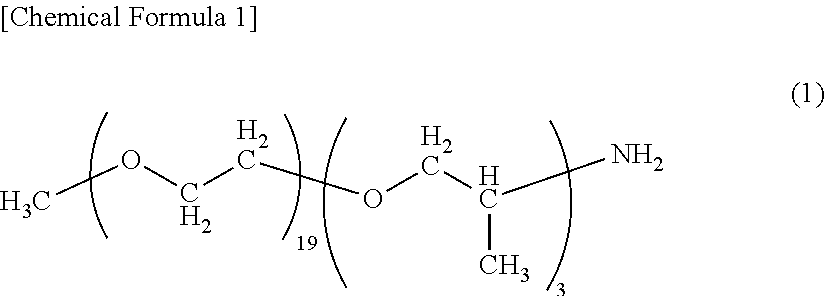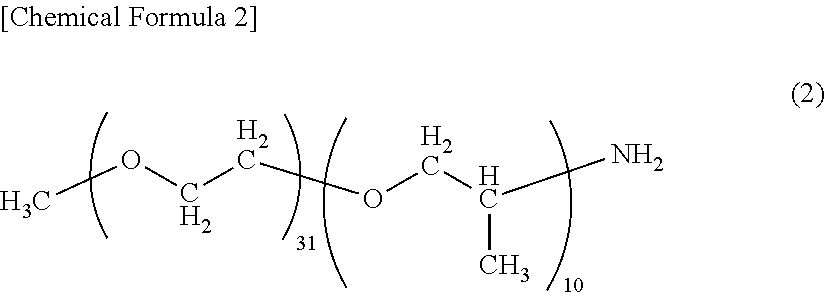End modified polyamide resin
a polyamide resin and end-modified technology, applied in the field of end-modified polyamide resins, can solve the problems of high viscosity, insufficient molding processability, high melt viscosity, etc., and achieve the effects of increasing molding processing temperature, melting viscosity, and thermal stability of polyamide resins
- Summary
- Abstract
- Description
- Claims
- Application Information
AI Technical Summary
Benefits of technology
Problems solved by technology
Method used
Image
Examples
example 1
[0137]700 g of ε-caprolactam, 175 g of ion-exchanged water, 53.9 g of “JEFFAMINE” M1000 and 1.4 g of acetic acid were added in a reaction vessel, sealed, and purged with nitrogen. The set temperature of a heater on the outer periphery of the reaction vessel was set to 260° C., and heating was started. After the internal pressure reached 1.0 MPa, the internal pressure was kept at 1.0 MPa while moisture was released to the outside of the system, and the temperature was elevated until the internal temperature reached 250° C. After the internal temperature reached 240° C., the set temperature of the heater was changed to 245° C., and the internal pressure was adjusted to turn to normal pressure over 1 hour (internal temperature at the time of reaching normal pressure: 245° C.) Subsequently, the reaction vessel was held while nitrogen was fed into the vessel (nitrogen flow) for 195 minutes, thereby obtaining an end modified polyamide 6 resin (maximum ultimate temperature: 250° C.). Subse...
example 21
[0144]331.2 g of hexamethylenediamine, 417.3 g of adipic acid, 175 g of ion-exchanged water, 30.1 g of “JEFFAMINE” M1000 and 5.6 g of acetic acid were added in a reaction vessel, sealed, and purged with nitrogen. The set temperature of a heater on the outer periphery of the reaction vessel was set to 290° C., and heating was started. After the internal pressure reached 1.75 MPa, the internal pressure was kept at 1.75 MPa while moisture was released to the outside of the system, and the temperature was elevated until the internal temperature reached 260° C. After the internal temperature reached 260° C., the set temperature of the heater was changed to 265° C., and the internal pressure was adjusted to turn to normal pressure over 1 hour (internal temperature at the time of reaching normal pressure: 270° C.) Subsequently, the reaction vessel was held while nitrogen was fed into the vessel (nitrogen flow) for 180 minutes, thereby obtaining an end modified polyamide 66 resin (maximum u...
example 22
[0145]270.7 g of hexamethylenediamine, 471.2 g of sebacic acid, 175 g of ion-exchanged water, 30.1 g of “JEFFAMINE” M1000 and 5.6 g of acetic acid were added in a reaction vessel, sealed, and purged with nitrogen. The set temperature of a heater on the outer periphery of the reaction vessel was set to 260° C., and heating was started. After the internal pressure reached 1.0 MPa, the internal pressure was kept at 1.0 MPa while moisture was released to the outside of the system, and the temperature was elevated until the internal temperature reached 240° C. After the internal temperature reached 240° C., the set temperature of the heater was changed to 245° C., and the internal pressure was adjusted to turn to normal pressure over 1 hour (internal temperature at the time of reaching normal pressure: 243° C.) Subsequently, the reaction vessel was held while nitrogen was fed into the vessel (nitrogen flow) for 195 minutes, thereby obtaining an end modified polyamide 610 resin (maximum u...
PUM
| Property | Measurement | Unit |
|---|---|---|
| particle diameter | aaaaa | aaaaa |
| particle diameter | aaaaa | aaaaa |
| melt viscosity | aaaaa | aaaaa |
Abstract
Description
Claims
Application Information
 Login to View More
Login to View More - R&D
- Intellectual Property
- Life Sciences
- Materials
- Tech Scout
- Unparalleled Data Quality
- Higher Quality Content
- 60% Fewer Hallucinations
Browse by: Latest US Patents, China's latest patents, Technical Efficacy Thesaurus, Application Domain, Technology Topic, Popular Technical Reports.
© 2025 PatSnap. All rights reserved.Legal|Privacy policy|Modern Slavery Act Transparency Statement|Sitemap|About US| Contact US: help@patsnap.com



